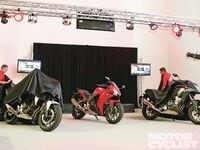Motorcycle journalists, highly trained cynics that they are, seldom express true surprise. Even less often amazement. So, you can imagine the chatter before Honda’s roll out of the few 2013 models we hadn’t already seen. Amid polite patter held over finger food and cold drinks on the typical subjects—bench racing and oblique character assassinations—we openly wondered what the hell we were going to see.
Honda guaranteed our attendance by saying it would introduce “six new models” for ’13. (Honestly, Honda, you had me at “light refreshments.”) But as I walked around the Honda Museum, pawing an impressive collection of the company’s two- and four-wheeled history (including Alex Zanardi’s Reynard/Honda in Target livery), I kept wondering what five of the six would be.
One bike I knew would be there: the CB1100. Honda, really excited about getting this model into the U.S., had invited journalists, one by one, for a brief ride near the company’s headquarters. Honda’s reps wouldn’t be drawn out on the rest of the 2013 lineup during the CB demo, even as I threatened to ride off with the only runner in the country. (My handler was on a CBR250R. Escape would have been easy.) Without actual information, I assumed the “six new” would be the 1100 plus five bikes with Bold New Graphics or maybe a light mechanical touch here and there, the equivalent of a vitamin shot to a patient with heart disease. The Honda of late is not a company to go big; it has become successful by being careful.
Oh, my. Bad assumptions. By the end of the night, the casually clad emissaries of the fourth estate had been treated to a rare display of Honda’s engineering might and economic risk taking. For a company that had charted a conservative approach to sportbikes and toyed with distractions like the crazy/expensive DN-01, the sheer amount of good sense that the new CB500 models made was breathtaking. Surprising, even. (For more, see Up To Speed, Pg. 8.)
Honda’s willingness to bring all three versions to our land is the story. I could see Big Red giving us one of them, tentatively, a cautious act signaling its lack of confidence in the market. (There’s some of that with the NC700, which has mega-scooter and naked variants elsewhere but only one model here.) Once the reality sunk in, I couldn’t decide if this is a Hail Mary move from Honda corporate or if someone in management woke up over his morning natto and said, “Hey, wait a minute. We’re Honda. We can do anything!”
And the bikes themselves looked really good. It was hard to know if the models were pre-production or something more advanced, but the paint, plastics and metalwork looked top notch—a tough task with a sub-$6000 price tag. We didn’t ride or even start any of the 500s, though I noted that one of the CBs was fueled and ready to go, with the key in it, even. I should have cranked it up just to listen to the engine, but I hadn’t had my fill of light refreshments yet and a couple of the Honda guys are pretty big.
Another shoe to drop was the Gold Wing F6B. In person, it’s gorgeous. The matte-finish radiator surrounds give it a menacing look, and the pieces intended to fill in where the Gold Wing parts are missing look positively seamless. From throwing a leg over it, the F6B feels like it lost every bit of the claimed 62 pounds. Yeah, the F6B is a rip on the Harley-Davidson Road Glide bagger, but at least it’s one with moxie and six pots of hellacious torque.
Funny thing. The one bike I assumed would have to carry Honda through 2013 turns out to be the one almost relegated to a side story by the time all the models were introduced. While the CB1100 will please a lot of riders and find easy sales, it’s Honda’s investment in the low-cost, utterly rational CB500 series that left the strongest and most positive impression.











/cloudfront-us-east-1.images.arcpublishing.com/octane/MUQLOVLL2ZDGFH25ILABNBXKTI.jpg)
/cloudfront-us-east-1.images.arcpublishing.com/octane/TNOU5DNE2BC57MFPMGN2EIDXAM.jpg)
/cloudfront-us-east-1.images.arcpublishing.com/octane/GTCXACQGJ5HAPDTGWUQKDEH44E.jpg)
/cloudfront-us-east-1.images.arcpublishing.com/octane/S35YGSEMEZB4BLTDJTSZPF4GLA.jpg)
/cloudfront-us-east-1.images.arcpublishing.com/octane/5UOT6HPX2JFMRJAX6EH45AR4MQ.jpg)
/cloudfront-us-east-1.images.arcpublishing.com/octane/OKWOJWAKP5EP3OACCRRWPCIX2Q.jpg)
/cloudfront-us-east-1.images.arcpublishing.com/octane/2WF3SCE3NFBQXLDNJM7KMXA45E.jpg)
/cloudfront-us-east-1.images.arcpublishing.com/octane/G4MG6OUCJNBSHIS2MVVOTPX65E.jpg)
/cloudfront-us-east-1.images.arcpublishing.com/octane/IIGGWFOTOJGB7DB6DGBXCCMTDY.jpg)
/cloudfront-us-east-1.images.arcpublishing.com/octane/QSTCM6AVEZA5JJBUXNIQ3DSOF4.jpg)
/cloudfront-us-east-1.images.arcpublishing.com/octane/U4I7G625B5DMLF2DVIJDFZVV6M.jpg)
/cloudfront-us-east-1.images.arcpublishing.com/octane/B6XD6LS6IVCQPIU6HXDJSM3FHY.jpg)
/cloudfront-us-east-1.images.arcpublishing.com/octane/ICL63FEDDRDTTMINYICCEYGMDA.jpg)
/cloudfront-us-east-1.images.arcpublishing.com/octane/FCGZHQXRBZFLBAPC5SDIQLVF4I.jpg)
/cloudfront-us-east-1.images.arcpublishing.com/octane/WNOB6LDOIFFHJKPSVIWDYUGOPM.jpg)

/cloudfront-us-east-1.images.arcpublishing.com/octane/X33NU3E525ECRHXLNUJN2FTRKI.jpg)
/cloudfront-us-east-1.images.arcpublishing.com/octane/6KKT5NNL2JAVBOXMZYS5ZO76YA.jpg)
/cloudfront-us-east-1.images.arcpublishing.com/octane/J5RKG5O455GMPGQRF2OG6LRT7A.jpg)
/cloudfront-us-east-1.images.arcpublishing.com/octane/GX2CIZKQVRH2TATDM26KFG2DAE.jpg)
/cloudfront-us-east-1.images.arcpublishing.com/octane/ZWIDYSAKQZHD5BHREMQILXJCGM.jpg)
/cloudfront-us-east-1.images.arcpublishing.com/octane/CYUHJZCTSJCH3MRAQEIKXK7SCQ.jpg)
/cloudfront-us-east-1.images.arcpublishing.com/octane/LKOFINY56FCXJCANJ5M7ZDQUBY.jpg)
/cloudfront-us-east-1.images.arcpublishing.com/octane/4NBPDACMWJH63JQYJVK3QRBDZI.jpg)